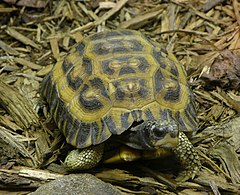Pyxis (żółw)
| Pyxis[1] | |||
| Bell, 1827[2] | |||
 Przedstawiciel rodzaju – żółw płaskoogonowy (P. planicauda) | |||
| Systematyka | |||
| Domena | |||
|---|---|---|---|
| Królestwo | |||
| Typ | |||
| Podtyp | |||
| Gromada | |||
| Rząd | |||
| Podrząd | |||
| Nadrodzina | Testudinoidea | ||
| Rodzina | |||
| Rodzaj | Pyxis | ||
| Typ nomenklatoryczny | |||
Pyxis arachnoides Bell, 1827 | |||
| Synonimy | |||
| Gatunki | |||
| |||
Pyxis – rodzaj żółwia z rodziny żółwi lądowych (Testudinidae).
Zasięg występowania
Rodzaj obejmuje gatunki występujące endemicznie na Madagaskarze[6][7].
Systematyka
Etymologia
- Pyxis: gr. πυξις puxis „pudełko, szkatułka”[8].
- Acinixys: gr. negatywny przedrostek α a „bez”[9]; κινεω kineō „poruszać”[10]; ἰξυς ixus „biodra”[11]. Gatunek typowy: Testudo planicauda Grandidier, 1867.
- Bellemys: Thomas Bell (1792–1880), angielski zoolog; εμυς emus, εμυδος emudos „żółw wodny” [12][4]. Nazwa zastępcza dla Pyxis Bell, 1827 ponieważ Williams uważał że nazwa ta jest zajęta przez Pyxis Chemnitz, 1784[a].
- Pyxoides: rodzaj Pyxis Bell, 1827; -οιδης -oidēs „przypominający”[13]. Gatunek typowy: Pyxoides brygooi Vuillemin & Domergue, 1972 (= Pyxis arachnoides Bell, 1827).
Podział systematyczny
Do rodzaju należą następujące gatunki[6]:
- Pyxis arachnoides Bell, 1827 – żółw pajęczynowy
- Pyxis planicauda (Grandidier, 1867) – żółw płaskoogonowy[14]
Uwagi
Przypisy
- ↑ Pyxis, [w:] Integrated Taxonomic Information System [online] (ang.).
- ↑ T. Bell. On two new Genera of Land Tortoises. „Transactions of the Linnean Society of London”. 15 (2), s. 395, 1827 (ang.).
- ↑ F. Siebenrock. Über zwei seltene Schildkröten der herpetologischen Sammlung des Wiener Museums. „Anzeiger der Kaiserlichen Akademie der Wissenschaften, Mathematisch-Naturwissenschaftliche Classe”. 39, s. 12, 1902 (niem.).
- ↑ a b E.E. Williams. Variation and selection in the cervical central articulations of living turtles. „Bulletin of the American Museum of Natural History”. 94, s. 512, 1950 (ang.).
- ↑ J.P. Vuillemin & Ch.E. Domergue. Contribution à l’étude de la faune de Madagascar: description de Pyxoïdes brygooi n. gen. n. sp. (Testudinidae). „Annales de l’Université de Madagascar”. Série sciences de la nature et mathématiques. 9, s. 193, 1972 (fr.).
- ↑ a b P. Uetz & J. Hallermann: Genus: Pyxis (ang.). The Reptile Database. [dostęp 2020-09-14].
- ↑ R. Midtgaard: Pyxis (ang.). RepFocus. [dostęp 2020-09-14].
- ↑ Jaeger 1944 ↓, s. 191.
- ↑ Jaeger 1944 ↓, s. 33.
- ↑ Jaeger 1944 ↓, s. 51.
- ↑ Jaeger 1944 ↓, s. 115.
- ↑ Jaeger 1944 ↓, s. 81.
- ↑ Jaeger 1944 ↓, s. 152.
- ↑ Praca zbiorowa: Zwierzęta: encyklopedia ilustrowana. Warszawa: Wydawnictwo Naukowe PWN, 2005, s. 366. ISBN 83-01-14344-4.
Bibliografia
- E.C. Jaeger: Source-book of biological names and terms. Springfield: Charles C. Thomas, 1944, s. 1–256. (ang.)
Media użyte na tej stronie
Autor: (of code) -xfi-, Licencja: CC BY-SA 3.0
The Wikispecies logo created by Zephram Stark based on a concept design by Jeremykemp.
Autor: Photo by Derek Ramsey (Ram-Man), Licencja: CC BY-SA 2.5
A photograph of the Flat-tailed Tortoiseen (Pyxis planicauda en ). Photo taken at the Philadelphia Zoo.
| |||

